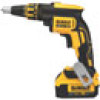Dewalt DCF620M2 Instruction Manual - Page 11
Storage Recommendations, SAVE THESE INSTRUCTIONS FOR, FUTURE USE, COMPONENTS FIG. 2
 |
View all Dewalt DCF620M2 manuals
Add to My Manuals
Save this manual to your list of manuals |
Page 11 highlights
English d. If charging problems persist, take the tool, battery pack and FIG. 2 D charger to your local service center. 4. The battery pack should be recharged when it fails to produce sufficient power on jobs which were easily done previously. DO NOT CONTINUE to use under these conditions. Follow the charging procedure. You may also charge a partially used pack whenever you desire with no adverse affect on the battery pack. 5. Foreign materials of a conductive nature such as, but not limited to, grinding dust, metal chips, steel wool, aluminum foil, or any buildup of metallic particles should be kept away from charger cavities. Always unplug the charger from the power supply when A B C H there is no battery pack in the cavity. Unplug charger before attempting to clean. G 6. Do not freeze or immerse charger in water or any other liquid. K WARNING: Shock hazard. Don't allow any liquid to get inside the charger. Electric shock may result. WARNING: Burn hazard. Do not submerge the battery pack in I J any liquid or allow any liquid to enter the battery pack. Never attempt to open the battery pack for any reason. If the plastic housing of the battery pack breaks or cracks, return to a service center for recycling. E Storage Recommendations 1. The best storage place is one that is cool and dry, away from direct sunlight and excess heat or cold. 2. For long storage, it is recommended to store a fully charged F COMPONENTS (FIG. 2) battery pack in a cool dry place out of the charger for optimal results. NOTE: Battery packs should not be stored completely depleted of charge. The battery pack will need to be recharged before use. WARNING: Never modify the power tool or any part of it. Damage or personal injury could result. A. Depth locator G. Trigger switch B. Screw depth adjustment collar H. Forward/reverse control lever SAVE THESE INSTRUCTIONS FOR FUTURE USE C. Locking collar D. Nose cone E. Battery release button I. Lock-on button J. LED worklight K. Belt hook F. Battery pack 9















